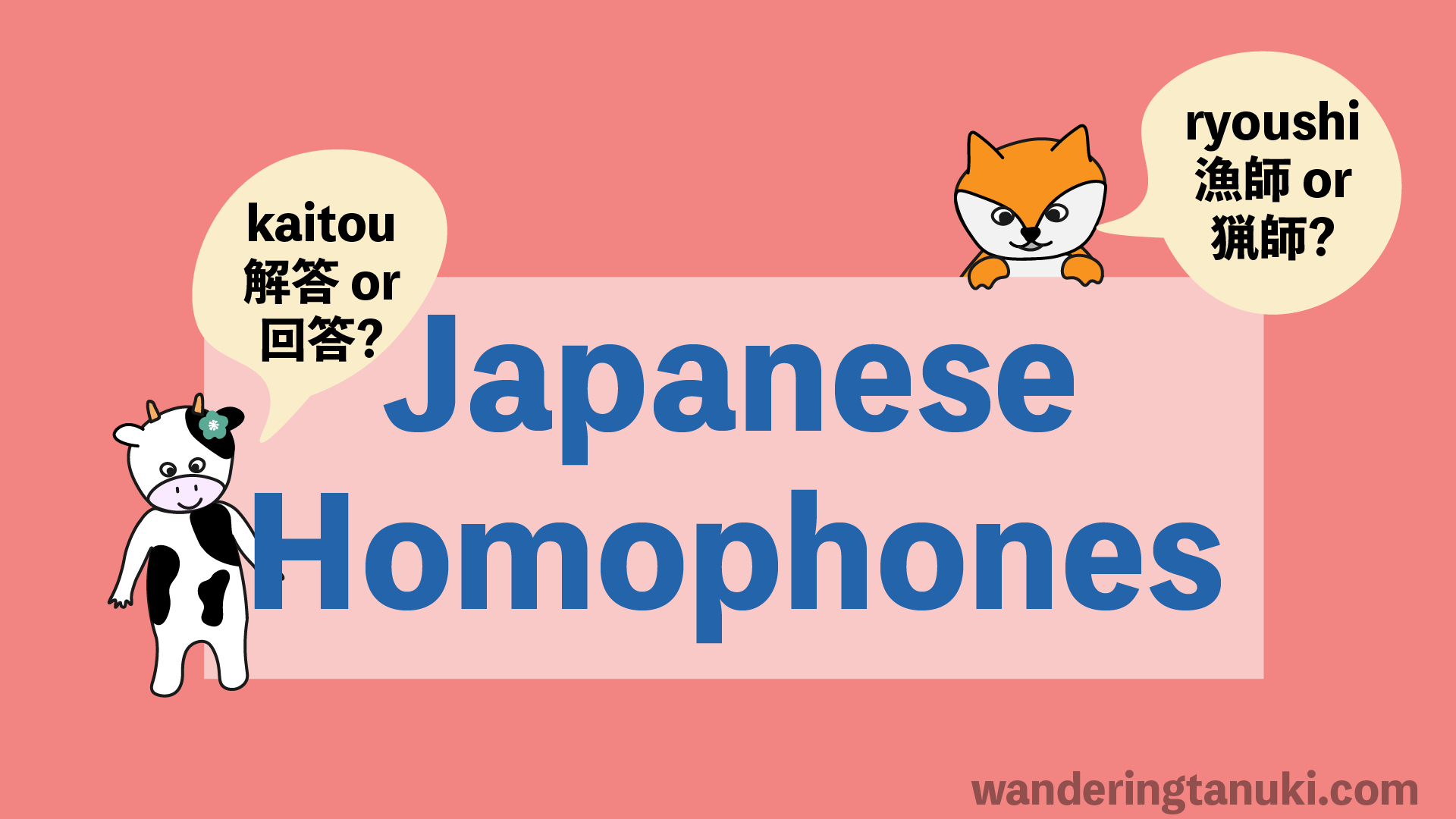13 Japanese Homophones: Same sound, different writing and meaning!
Homophones in Japanese can be confusing because you have to make the correct decision on which kanji to use, depending on the meaning! If you’re unfamiliar with what homophone means, it is a word that is pronounced the same way but has different meanings. In English, an example is “two” and “to.”

You might notice that many of these words have similar meanings with only slight differences. Japanese people like to create nuance with the written kanji to convey and add depth to the text. You’ll be able to appreciate the use of these homophones most often in writing.
Here is a list of 13 Japanese homophones you might encounter. I put together this list with a particular emphasis on making sure they are exact homophones. This means that even the accentuation of the words is the same. Listen to each audio clip to also learn how to say them.
Note that this isn’t a complete list, and you may discover more as you go!
1. Ryoushi
What makes these two words different is the first kanji character for fisherman and hunter. 漁 means “to fish,” and 猟 means “to hunt.” The second kanji character 師 is the same for both words and means master, mentor, or teacher.
漁師 – Fisherman
漁師は毎日船に乗らないといけない。
Roushi wa mainichi fune ni noranai to ikenai.
Fishermen must go on a boat every day.
猟師 – Hunter
森に猟師がいた。
Mori ni ryoushi ga ita.
There was a hunter in the forest.
2. Kaishin
With the two ways of writing kaishin, there are incredibly different meanings. The first one, which means satisfaction, uses the kanji “to meet” and “heart.” The second uses the kanji for “revision” and “heart.”
会心 – Satisfaction
学校で出会った友達は会心の友。
Gakkou de deatta tomodachi wa kaishin no tomo.
The friends I got to know at school are satisfying friendships.
改心 – Change of heart
今年は改心して日本語の勉強をする。
Kotoshi wa kaishin shite nihongo no benkyou o suru.
This year I will have a change of heart(reform my study habits) and study Japanese.
3. Kagaku
A very confusing homophone is these two words for kagaku. Both appear in scientific contexts, but 科学 means science and 化学 mean chemistry.
科学 – Science
科学に興味がある。
Kagaku ni kyoumi ga aru.
I have an interest in science.
化学 – Chemistry
化学反応を研究している。
Kagaku hannou o kenkyuu shite iru.
I am studying chemical reactions.
4. Taishou
This homophone can be three very different things. The first is to be a “subject of,” the second is to “contrast/compare,” and the third can mean “symmetry.”
対象 – the subject of (something)
大統領は批判の対象になってしまった。
Daitouryou wa hihan no taishou ni natte shimatta.
The president became the subject of criticism.
対照 – contrast or compare
二つの味を対照する。
Futatsu no aji o taishou suru.
I compare the two flavors.
対称 – symmetry
この建物は対称的です。
Kono tatemono wa taishou teki desu.
This building is symmetrical.
5. Seikaku
The two words for seikaku are common words that you’ll hear in everyday Japanese. Study the kanji to know which one to use when writing.
性格 – personality
彼は性格が悪い。
Kare wa seikaku ga warui.
He has a bad personality.
正確 – accurate
正確な時間が知りたい。
Seikaku na jikan ga shiritai.
I want to know the precise time.
6. Kousei
“Kousei” can have many ways of writing that all mean different things! The example sentences should help you to understand how to use each one.
校正 – proofread
この本は校正の間違えがたくさんある。
Kono hon wa kousei no machigae ga takusan aru.
This book has many proofreading mistakes.
公正 – justice
公正な裁判が行われることを願っています。
Kousei na saiban ga okonawareru koto o negatte imasu.
I hope that the trial will be held judiciously.
構成 – organization
作文を書く時には文の構成をよく考えた方がいい。
Sakubun o kaku toki ni wa bun no kousei o yoku kangaeta hou ga ii.
When you write an essay, you should think about the organization of your writing.
厚生 – public benefit
この町にはたくさんの更生施設があります。
Kono machi ni wa takusan no kousei shisetsu ga arimasu.
This town has many public benefit facilities.
攻勢 – aggression/offensive
彼はチェスが強いのでいつも攻勢に出ている。
Kare wa chesu ga tsuyoinode itsumo kousei ni deteiru.
He is good at chess, so he is always on the offensive.
更生 – reform (person)
彼はアルコール中毒だったが自力で更生した。
Kare wa arukooru chuudoku datta ga jiriki de kousei shita.
He had an alcohol addiction, but he overcame it by himself.
7. Kaitou
These Japanese homophones have two similar meanings but apply to different contexts. The first is more of an answer/reply to questions like a survey, and the second is an answer for problems you solve, like in a test.
回答 – an answer that is a reply
ご回答ありがとうございます。
Gokaitou arigatougozaimasu.
Thank you for your reply(answer).
解答 – an answer to a problem you solve
テストの解答が見たいです。
Tesuto no kaitou ga mitai desu.
I want to see the test answers.
8. Kaihou
Like some other homophones, kaihou has similar meanings but should be written differently depending on the context. Both mean something is opening or let out.
解放 – set free, emancipation
人質を解放しました。
Hitojichi o kaihou shimashita.
The hostages were set free.
開放 – open up (to the public)
新しい施設が開放する。
Atarashii shisetsu ga kaihou suru.
The new facility will open up to the public.
9. Au
Au has two kanji that look very similar! However, these Japanese homophones have very different meanings.
会う – to meet
友達に会いに行きます。
Tomodachi ni ai ni ikimasu.
I will go meet my friend.
合う – to fit
その洋服がとても似合う。
Sono youfuku ga totemo niau.
Those clothes suit you well.
10. Hakaru
The primary definition you’ll find with hakaru is “to measure.” However, it’s essential to differentiate between measuring weight, dimensions, or time in Japanese. An additional meaning to hakaru is “to devise” or “to plan,” which also uses its unique kanji character.
図る – to plan/devise
事件の解決を図る。
Jiken no kaiketsu o hakaru.
We are devising the solution to the case.
量る – to measure weight
体重を量る。
Taijuu o hakaru
I measure my weight.
測る – to measure length, width, depth, or area
テーブルの長さを測る。
Teeburu no nagasa o hakaru.
I measure the length of the table.
計る – to measure time
時間を計る。
Jikan o hakaru.
I measure the time.
11. Yoi
These two kanji both mean“good.” However, because 好い is made up of the kanji characters for “woman,” 女, and “child,” 子, there is a warmer tone. In comparison, 良い is the standard way of saying “good.”
良い – good
評判が良い。
Hyouban ga yoi.
The reputation is good.
好い – good (warm nuance)
天気が好い。
Tenki ga yoi.
The weather is good.
12. Tsukuru
The three versions of “tsukuru” mean “to make” but have different usages. 作る means to make something from small or shapeless objects like a seed growing into a vegetable. 造る applies to creating something that is physically big, like a building. The third one, 創る, is when you’re making something significant like the “future,” “artwork,” or “a better tomorrow.”
作る – make (from small or shapeless object)
野菜を作るのが好きです。
Yasai o tsukuru no ga suki desu.
I like to grow (make) vegetables.
造る – make (something big)
自分で庭園を造りたいです。
Jibun de teien o tsukuritai desu.
I want to make a garden by myself.
創る – make (from nothing, meaningful)
素晴らしい芸術を創りたいです。
Subarashii geijutsu o tsukuritai desu.
I want to make beautiful art.
13. Susumeru
Susumeru can have many meanings, from moving forward to recommending and persuading. The best way to learn them is by looking at the examples!
進める – to move forward, progress
プロジェクトの計画を進める。
Purojekuto no keikaku o susumeru.
The project plan is moving forward.
勧める – to recommend an action
あのレストランで食べるのを勧める。
Ano resutoran de taberu no o susumeru.
I recommend eating at that restaurant.
薦める – to recommend a person or object to someone
山田さんを会長に薦める。
Yamada san o kaichou ni susumeru.
I recommend Mr. Yamada as the chairperson.
I hope these Japanese homophones gave you a glimpse into how Japanese can be written differently to portray nuances or even different meanings. There are many more than listed here that you’ll discover as you learn Japanese. If you’re interested in more Japanese learning blog content, be sure to check out my other articles like What is Romaji? or 24 Japanese Animal Sounds or Onomatopoeia!
~ Tanuki





